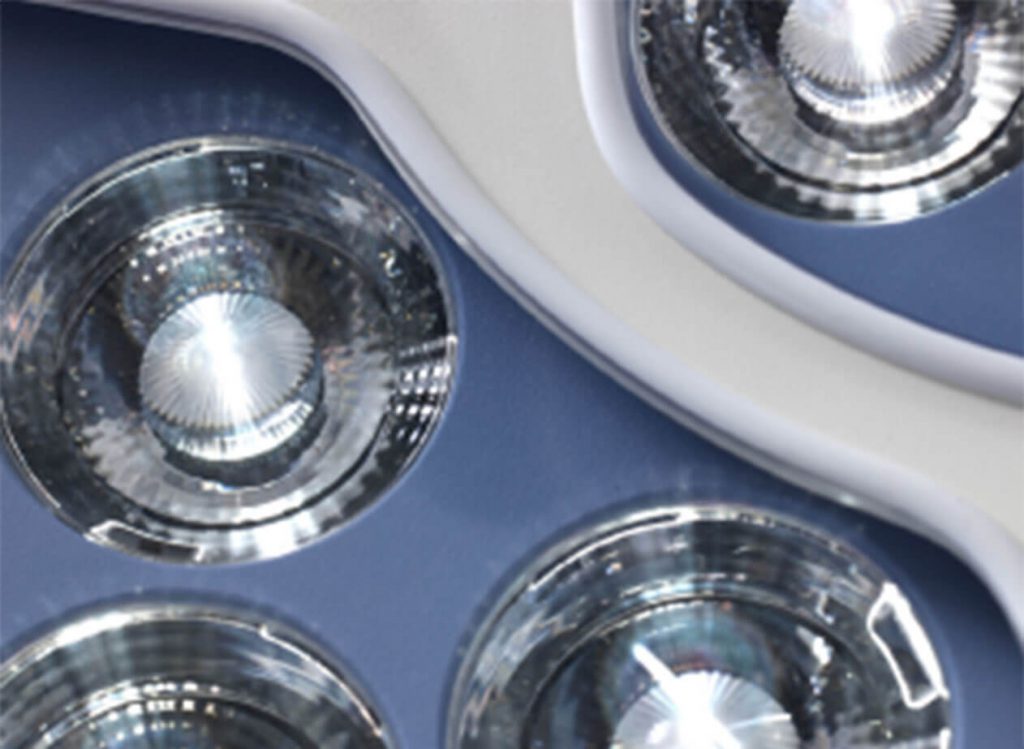Whether you’re looking to light a surgical theatre, examination room, dentist chair or veterinary clinic you need specialty lighting. Medical procedure lights, examination lights and other types of specialty medical lights have specific properties required to perform delicate tasks like surgery and examinations.
Conventional lighting isn’t adequate for medical work because of its colour profile, ambient heat, and tendency to create shadows. All these properties can cause problems when carrying out delicate medical work.
There are three important factors that separate medical lighting from conventional lighting. These are light colour (or whiteness), heat and radiation, and light shadow.
Light colour: Light colour and “whiteness” matters when it comes to surgical or examination lighting. Light whiteness is important for properly seeing colours. Surgeons, doctors and veterinarians need to distinguish different colours in flesh and body fluids with great accuracy. Conventional lighting usually has tones of red, blue or green in it which can subtly alter how we see colour. Medical lighting, on the other hand, has a high level of whiteness.
Medical lighting has what we call a high colour temperature. Colour temperature indicates how light appears. Lower colour temperatures (i.e. lower the degrees Kelvin) have more yellow, while higher colour temperatures (also known as “daylight”) are much whiter. LED procedure lights have an extremely high colour temperature, which makes for optimal perception of colour.
Heat and radiation: Conventional lights use filaments made from tungsten, which are heated to high temperatures to generate the light. This process releases large amounts of heat. Since medical procedures are dealing with delicate exposed tissue, you don’t want to be applying any ambient heat to the area.
LED lights generate much less ambient heat radiation, which makes them ideal for medical procedures and other delicate activities.
Light Shadows: Shadow control is very important for surgical procedures. Shadows which can obscure the view of the area under inspection, and impact the perception and accuracy of the doctor.
There are two main types of shadows: contour shadows and contrast shadows. Contour shadows are useful in medical examinations and surgery as they help with creating textures and with gauging depth and volume. Contrast shadows, on the other hand, create dark spots and obscure the view.
Medical lighting requires multiple light bulbs on multiple heads to illuminate the area simultaneously from a variety of different angles.
Additional Factors to Consider
Besides the basic light properties, there are a variety of other factors you need to consider before selecting your lighting.
Shadow and glare management: Medical examinations involve intensive procedures that require an unobscured view of the examination area. Shadows can be caused by the heads, bodies and arms of the medical team, temporarily obscuring the field of view.
Using multiple light sources that can be easily cross-focused can virtually eliminate shadows.
It’s also important to consider glare from the lighting. Glare can cause eye fatigue, vision blurring and loss of focus. Care should be taken with the arrangement of the lights and the arrangement of any reflective surfaces around the room to ensure minimal reflection and glare.
Intensity of illumination: Medical procedure lights need to be chosen based on the intensity of illumination. Illuminance, or light output, is the measurement of how much light falls on a surface per square metre and is measured in lux. According to technical and operation guidelines, light output should range between 40,000-160,000 lux for surgery, while examination light requires a minimum of 1,000 lux.
Backup power source: A power outage in the middle of a medical procedure can have severe consequences. It’s essential for surgical and examination lighting to run on multiple power sources or be equipped with generator or battery backups.
Integration with imaging equipment: It’s common for surgical, dental and veterinary lighting to be integrated with high-definition audio/visual equipment. These may be required to provide imaging for surgical cameras, for educational purpose, or to allow patients to view certain areas.
Different lighting setups have different functionality when it comes to integrating imaging equipment. It’s important to understand your requirements and discuss them with your retailer.
Mobility: Mobility or portability is a common requirement for surgical or examination lights. Mobile lights mounted on wheeled frame allow easy movement around the area under inspection or surgical cavity. This offers the benefit of efficient light positioning with reduced shadow.
Disposing of existing lighting: Regulations for disposing of LED lighting tend to differ across regions. Besides the regulations, it’s important to dispose of LED lighting in a way that is environmentally considerate and financially smart. Some companies offer recycling and return options at the end of medical procedure lights. Talk to your retailer before you make your purchase to find out how to best dispose of your existing lighting.

At H.E. Technical Services, we have been servicing the medical industry since 1972. We supply, install and maintain surgical, examination and veterinary lights across Australia. For more information on how to select the right medical-grade lighting, call us on (03) 9775 0557 or contact us online.
